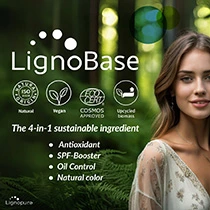Portuguese researchers develop fully bio-based cosmetic packaging material

A fully bio-based packaging composite mimicking the properties of fossil-based plastics is offering an alternative and environmentally sustainable solution for cosmetic applications. Scientists in Portugal have developed “the first” biodegradable material using PHBV (plastic produced naturally by bacteria), polylactic acid, citosan, essential oil, a bioplastizer, and phycocyanin.
“The bio-based material composite distinguishes itself through its sustainability and the use of bio-based polymers and natural fibers (such as citosan) and other bio-active compounds to achieve good final properties for the cosmetic packaging application,” Fátima Santos, study author and researcher at the University of Coimbra, Portugal, tells Packaging Insights.
“The final material can be tailored to specific forms and shapes,” she adds. “Another important aspect of this development is the technologies used to produce it. Fused Granular Fabrication is being increasingly used and presents several advantages: it allows for the use of pellets as a raw material, eliminating the need for filament production.”
Packaging of the Future
The study published in Nature was conducted by researchers at the University of Coimbra, the University of Minho, and the Polytechnic Institute of Leiria as part of NABIA (New Approach to Biorremediation using Algae) and the Embalagem do Futuro (Packaging of the Future) project sponsored by the EU and the Portuguese Government.
“This is a major consortium of 79 industries and universities with the joint goal of developing more environmentally friendly, digital, and inclusive packaging solutions, promoting circular economy principles and competitive and technological innovation in the sector,” says Santos.
.jpg) Fátima Santos, study author and researcher at the University of Coimbra.“The consortium has the goal to create innovative products and processes that contribute to a more sustainable and competitive sector.”
Fátima Santos, study author and researcher at the University of Coimbra.“The consortium has the goal to create innovative products and processes that contribute to a more sustainable and competitive sector.”
The researcher adds that her latest study aims to tackle global problems associated with fossil-based plastics and “the urgent need to find alternatives to these ubiquitous and damaging materials in our day-to-day lives and at the same time, create a new and distinctive packaging for cosmetics.”
No more “plastic smell”
Santos explains that the inclusion of phycocyanin and essential oils enhances the properties and sustainability profile of the material in multiple ways.
She points out that “environmentally friendly” products still have an environmental footprint. “In our work, we pursue minimizing harm and lowering our environmental footprint.”
“Usually, elements that impart a smell to plastic materials, such as essential oils, are of synthetic origin, and most are considered endocrine-disrupting chemicals. The essential oil used in our study is of natural origin, derived from plants and certified as such. It comes from a renewable source, in contrast with the ones from a petrochemical origin.”
Santos adds that sensory characteristics such as the texture, color, and odor also differentiate brands’ attributes and present marketing opportunities.
“These attributes can help the consumer evaluate and select cosmetic products. For instance, the odor present in the packaging material can be the same as the product inside it.”
Sensory cues in packaging are suitable and can create a positive first impression, reinforcing marketing messages and promoting product loyalty, according to Santos.
The researcher adds that the pigment used by her team is naturally blue, which she explains is the rarest color naturally present in nature. The color is extracted from the spirulina microalgae.
“It is well known that the bio-active compounds, such as essential oils and phycocyanin, degrade under high temperatures. But, with the appropriate processing parameters, the preservation of the colors can be guaranteed.”
 The bio-based material composite uses bio-based polymers, natural fibers, and bio-active compounds (Image credit: University of Coimbra).Besides the bio-active profile, she says that the composite’s mechanical properties are also interesting due to their similarity to fossil-based polymers, such as PP and PE.
The bio-based material composite uses bio-based polymers, natural fibers, and bio-active compounds (Image credit: University of Coimbra).Besides the bio-active profile, she says that the composite’s mechanical properties are also interesting due to their similarity to fossil-based polymers, such as PP and PE.
Reduce cost and waste
According to Santos, the material stands out from other bio-based alternatives currently in the market or under development.
“It facilitates experimentation, reduces costs and waste, and it can be recycled as plastic directly after a pelletizing step, all of which enhance sustainability and adhere to the principles of the circular economy,” she says.
The researchers used additive manufacturing (AM), also known as 3D printing, to evaluate the material’s printability, layer adhesion, and degradation.
“AM is a relevant manufacturing technique to evaluate design, performance, and visual appearance of the material of prototypes,” Santos explains. “Injection molding technique requires a high-cost mold.”
“AM allows us to test beyond physical/chemical material properties; it allows us to evaluate complex geometries and personalized designs and perform adjustments in a fast, low-cost, and practical way.”
Santos argues that AM has been important in demonstrating the possibility of printing the new material.












